Three months away from the world title match
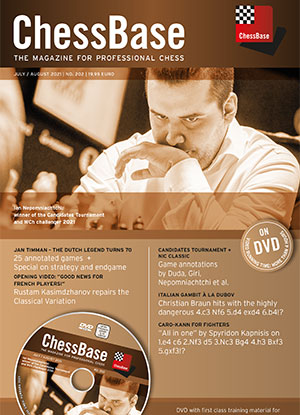 Even as I write these lines, I read the announcement that Carsen would be playing in the Aimchess US Rapid, commencing on August 28.
Even as I write these lines, I read the announcement that Carsen would be playing in the Aimchess US Rapid, commencing on August 28.
Of course, he knows he will be playing the world championship match with Nepomniachtchi soon and only 90 days are left. Obviously, he believes the best preparation for the duel is practice with his peers in tournament arena. Recently he had done just that and participated in the World Cup only to be eliminated in the semi-final by Duda, who went on to win the precious title. The challenger on the other hand has waited in the wings and watched his rival’s play. He knows, a world championship match is different from a tournament, however high its category and rating may be.
In this issue of ChessBase Magazine, readers would find all the games from the Candidates’ Tournament. Nepomniachtchi annotates his own game with Wang Hao.
If we set aside his aggressive performance against Alekseenko, Nepomniachtchi played pragmatic chess and his survival skills paid off in the end (see his interview below).
I was more impressed by his game with Ding Liren in the first half, which is also included in this issue.
In creative terms, the Game of the Tournament was the Caruana vs Vachier-Lagrave encounter. In this issue, it is annotated by Romain Edouard. When I studied the game, I checked his analysis and those of other experts. I also found some recent developments related to the opening of this game. Now discerning readers know that this particular line, the Poisoned Pawn Variation, has a chequered history. Back in the 1950s, Keres and Tal upheld the line for White; subsequently, Tolush and Fischer did it for Black. If one has to appreciate this game, it helps to know how the whole line has evolved. Here I have kept the annotations relatively simple for readers not familiar with theory. The final phase of the game receives detailed treatment by Karsten Müller in this issue. Worth a look.
Before we look at the game, I have a suggestion for young players. First, study the game without GM annotations and engine analysis. Then you see it with the commentary here and ChessBase Magazine. You will find a wealth of variations.
Note that the first game in the list does not include annotations; the second one does
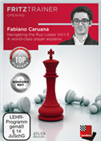 The Ruy Lopez is one of the oldest openings which continues to enjoy high popularity from club level to the absolute world top. In this video series, American super GM Fabiano Caruana, talking to IM Oliver Reeh, presents a complete repertoire for White.
The Ruy Lopez is one of the oldest openings which continues to enjoy high popularity from club level to the absolute world top. In this video series, American super GM Fabiano Caruana, talking to IM Oliver Reeh, presents a complete repertoire for White.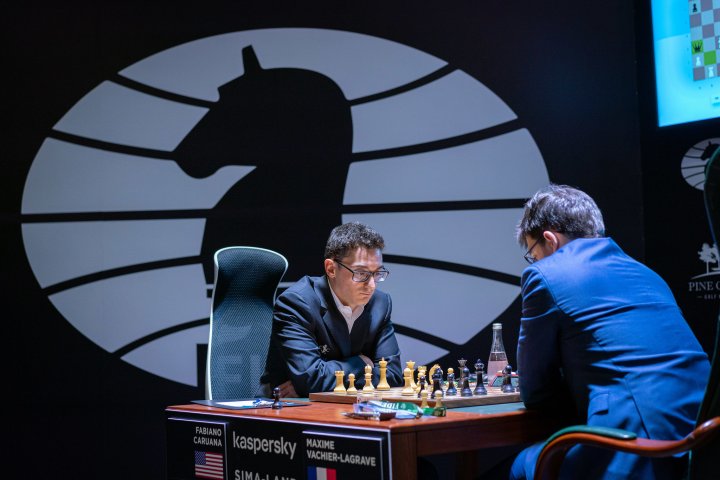
Fabiano Caruana facing Maxime Vachier-Lagrave | Photo: Lennart Ootes / FIDE
Magnus is at last happy!
The second tournament report is on the New in Chess Classic 2021, won by Carlsen. He hadn’t won a proper tournament for months this year. So this victory was very satisfying.
He dominated the event, first eliminating Radjabov and Aronian, and then overcoming Nakamura in the final.
Peter Heine Nielsen annotates the decisive encounter between the finalists:
Note that the first game in the list does not include annotations; the second one does
Readers should not miss out other games, though. Veterans Aronian and Mamedyarov shone time and again, while young talents Duda and Alireza Firouzja did not do badly.
St. Petersburg prevails over Moscow
This issue also includes all the games from the Russian Team Championship, Sochi. As is known, St. Petersburg’s Bronze Horsemen prevailed over the Moscow Chess Team that finished second. The rivalry between the two cities — St. Petersburg was known as Leningrad in the Soviet era — is legendary, and still continues.
Moscow fielded more than one team in this competition. None came close to crowning glory, and it was not for want of trying. In the following game, young Predke goes all out to beat his more experienced opponent:
Among other teams, “Tyumen Wild Berries Youth” made quite an impression. Here we see their leader, Daniil Dubov, playing Nikita Vitiugov on the first board for the St. Petersburg Bronze Horsemen.
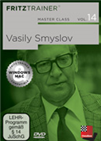 Smyslov cultivated a clear positional style and even in sharp tactical positions often relied more on his intuition than on concrete calculation of variations. Let our authors introduce you into the world of Vasily Smyslov.
Smyslov cultivated a clear positional style and even in sharp tactical positions often relied more on his intuition than on concrete calculation of variations. Let our authors introduce you into the world of Vasily Smyslov.
This game, with a fascinating opening experiment by Dubov, ended in a draw | Photo: Vladimir Barsky / Russian Chess Federation
He challenged Karpov and Kasparov
Before we come to the special feature in this issue, here is a question for our young readers: who are the two friends sharing a carefree moment here?
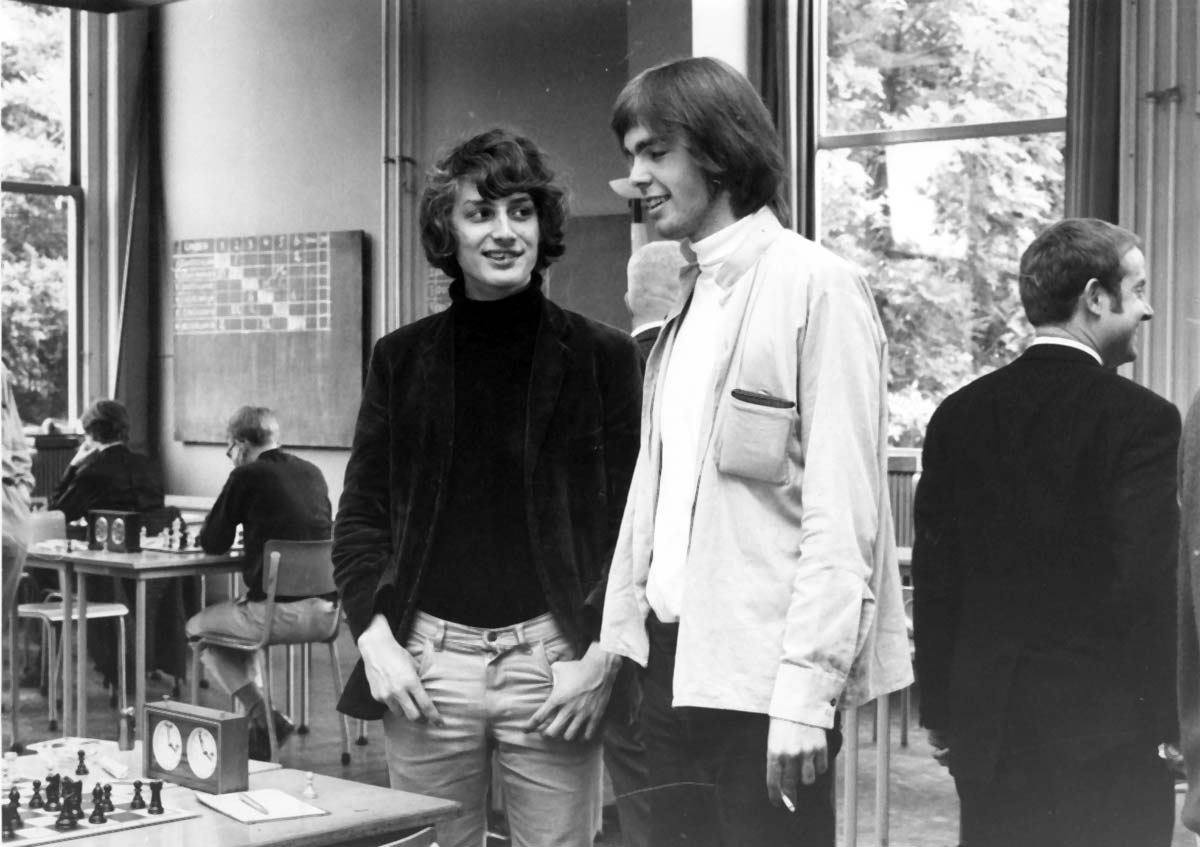
Here an older reader would interject, “I don’t wish to be a spoilsport, but aren’t they Jan Timman and Hans Bohm?”
That’s right. In the picture here they are seen in Biel Open Chess Tournament, 1969. Timman won the main event with 9/11 and Hans Böhm shared 3-6 places with other players on 7½/11. To his credit, Böhm also won the speed event.
Both became strong players. But it was Jan who went far and represented a serious challenge to both Karpov and Kasparov, competing with them in tournaments and matches.
Only the other day he turned 70 and this issue offers him a tribute. There are 25 deeply annotated games with some of the greatest players in modern chess: Tal, Larsen, Korchnoi and Karpov, to mention a few. It’s a miniscule sample of his play. MegaBase alone offers more than 4000 of his games.
Opening videos and surveys
There are 3 opening videos in this issue. The first features a lecture on the Classical French by Rustam Kasimdzhanov; the second offers a lecture on the Smyslov Variation of the Grünfeld defence by Mihail Marin; and the third is an introduction to the Albin Counter-Gambit by Daniel King. Take your pick.
Incidentally, there are as many as 12 opening surveys, ranging from the Caro-Kann to the King’s Indian. Nimzo-Indian fans should check out the second part of the survey on the Saemisch Variation (4.f3).
Besides opening surveys, this issue has standard features on tactics, strategy and the endgame.
Summing up
The main database of the issue has 456 recent games, of which 48 are deeply annotated.
Commentators include Ian Nepomniachtchi, Boris Gelfand and Anish Giri, among others. Major contributions are made by Michal Krasenkov (16 games) and Romain Edouard
(20 games).
It may be noted that there are more annotated games in the sections on opening theory and training.
Well, practice makes perfect.
Notes
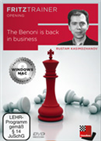 On top level the Benoni is a rare guest but with this DVD Rustam Kasimdzhanov this might change. New ways and approaches in most lines and countless improvements of official theory will show you how to play this opening at any level with success.
On top level the Benoni is a rare guest but with this DVD Rustam Kasimdzhanov this might change. New ways and approaches in most lines and countless improvements of official theory will show you how to play this opening at any level with success.
- Both Nepomniachtchi and Vachier Lagrave have offered insights on the Candidates’ 2020-2021
Interview with Ian Nepomniachtchi conducted by the Russian Chess Federation
Maxime Vachier Lagrave wrote two blog posts on his performance in the Candidates’: Leading the Candidates | Candidates: see you next time!
There have been a couple of books on the Candidates’ Tournament 2020-2021. The first of them is Eight Good Men, edited by Dorian Rogozenco and published by Elk and Ruby. A pdf sample of the book can be found in this link.
The second is a Russian title, Шахматная пьеса с антрактом на ковид. Турнир претендентов. Екатеринбург 2020–2021 by Vladimir Tukmakov.
Only the first half of the Russian text has found its way in English so far: A Feast of Chess in Time of Plague - Candidates Tournament 2020 - Part 1 – Yekaterinburg.
- Way back in 1995 Jan Timman brought out a book, Timman’s Selected Games of Chess. This is still eminently readable. More recently New in Chess has published two titles, Timman’s Titans and Timman’s Triumphs.
Links
.jpeg)

















 Even as I write these lines, I read
Even as I write these lines, I read 







